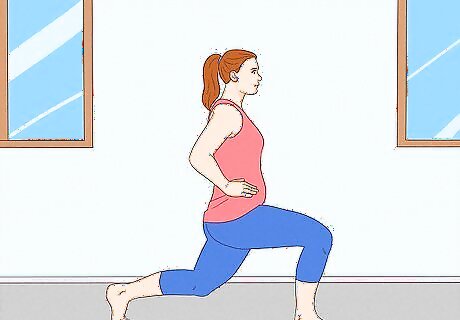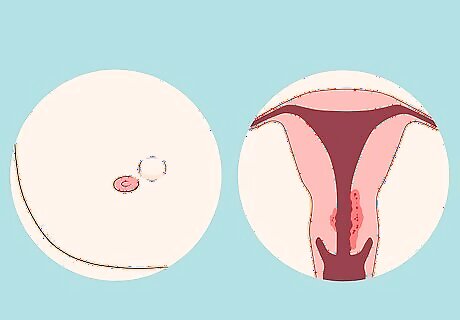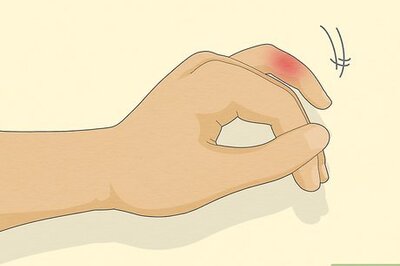
views
- Do cardio and strength training exercises and eat healthfully to lose weight all over—unfortunately, you can’t spot-treat an apron belly.
- Medical procedures, such as a tummy tuck or a panniculectomy, can help reduce or eliminate apron belly if exercise and dieting don’t seem to help on their own.
- In the meantime, you can minimize the discomfort caused by apron belly by applying anti-chafing creams and keeping the area clean and dry.
How to Eliminate Apron Belly

Do 75-150 minutes of aerobic exercise each week. You can’t target your apron belly specifically. However, losing weight all over your body will help to eliminate or reduce your apron belly, and exercising can certainly help with that. Try to get at least 150 minutes a week of moderate aerobic activity, or 75 minutes of vigorous aerobic activity. You can meet your weekly aerobics quota by jogging or hiking a few days a week, taking a dance class, or doing anything that gets your body moving and your heartrate up. High intensity interval training (or HIIT) is particularly effective for weight loss. HIIT refers to an exercise routine alternating short bursts of intense aerobic exercise (like jump-roping, burpees, or planking) with brief recovery periods. Build exercise into your day with NEAT. NEAT, or non-exercise activity thermogenesis, refers to anything that gets your body moving, even if it’s not technically a “workout.” Think walking instead of driving, mopping the floor, or taking the stairs instead of the elevator.

Strength train twice a week. Cardio can help you slim down, but building muscle through strength training will help you burn calories more efficiently. Aim to do strength training 2 days per week. There are a lot of great strength training exercises you can do at home without any equipment—just your body. Try planks, lunges, squats, pull-ups, and push-ups. You can use barbells or dumbbells to strength train, but if you don’t have access to these, try making a homemade weight set using soup cans or other household objects.

Up your lean protein intake. Eat plenty of lean protein every day to stay energized. Protein takes a while to digest, meaning you stay fuller longer. It also strengthens your muscles, another green flag if you’re trying to lose weight. Try to eat at least about 0.8 grams of protein per kilogram of body weight (or 0.36 grams per pound) each day, and ensure about 10-35% of your daily caloric intake comes from protein. For instance, if you weigh 140 pounds, multiply 140 by .36 to get 50.4 grams of protein. In kg, multiply 63.5 kg by .8 to get 50.8. You can also input your info into the USDA's DRI (dietary reference intake) app to calculate exactly how much protein your body needs each day. Stock up on animal-based proteins like chicken, salmon, eggs, milk, yogurt, and cheese, or plant-based proteins like edamame, lentils, almond milk, seitan, and tofu.

Cut about 500 calories daily. Burning more calories than you consume each day can help you shed pounds. Aim to consume about 500 calories fewer than you usually eat. The average person requires about 2000 calories a day to maintain their weight, so if you want to reduce your apron belly, try to consume about 1500. Avoid getting fewer than 1200 calories per day. While severely restricting calories may seem like an easy route to weight loss, it’s ultimately not healthy or sustainable. The most effective way to lose weight and keep it off is by taking it slow and entering a manageable, consistent calorie deficit. Try food tracker apps like My Fitness Pal or LifeSum to record roughly how many calories you’re getting every day.

Consider cosmetic treatments. Cosmetic procedures, such as laser liposuction, CoolSculpting, or a tummy tuck, may help minimize or eliminate your apron belly if exercise and dietary changes alone don’t seem to be helping. These procedures are both low-risk and require little to no recovery time, and results are permanent as long as you continue to maintain a healthy diet and exercise regularly. Laser liposuction (also called laser lipolysis) is a minimally invasive surgery involving using a laser to melt the fat under the skin. It may require a couple of days’ recovery and generally costs between $2,500 to $5,450, but the effects are immediate, unlike the effects of CoolSculpting, which may take several months. CoolSculpting (or cryolipolysis) is a non-invasive, non-surgical procedure in which a cooling applicator is used to freeze fat beneath the skin. The frozen fat cells die and are slowly absorbed by your body over several months. It generally requires no recovery time, and often costs somewhere between $2000 to $4000. Abdominoplasty, a.k.a. a tummy tuck, is another effective surgical option. It’s a lot like liposuction, except that after the fat is removed, the excess skin is also removed. A tummy tuck tends to cost around $6000.

Talk to your doctor about a panniculectomy. A panniculectomy is a surgery that removes the pannus. In this procedure, which may last up to 5 hours, a qualified surgeon makes 2 incisions on the abdomen, removes excess fat and skin, and stitches the skin back together. A panniculectomy is not considered a cosmetic procedure, but it may be covered by your health insurance if you meet certain requirements, such as being in pain caused by your apron belly, being in general good health, not smoking, and maintaining a healthy diet and exercise routine. Having the pannus removed can make your abs flatter, but if you want an even tighter tummy, you might consider pairing a panniculectomy with a tummy tuck.
Apron Belly Overview and Causes

Apron belly refers to the apron-like appearance of fat over the abdomen. Apron belly—also known as a pannus stomach or a mother’s apron—is caused by excess fat deposits in the omentum, an apron-like flap under the abdominal muscles, in front of the intestines. The size of an apron belly varies. On some people, an apron belly hangs only a few inches, to the top of the pubic area, and on others, it extends all the way to the knees. Pregnancy is a common cause of apron belly: as the stomach stretches to accommodate a baby, the abdominal muscles weaken, which may lead to apron belly postpartum. Obesity is another common cause of apron belly, as people who are overweight or obese may be more likely to accumulate fat in their abdominal area. Certain medical conditions, like Cushing’s syndrome or type 2 diabetes, may lead to weight gain, including excess weight stored in the abdominal area. Genetics may lead to apron belly as certain people may be genetically predisposed to weight gain in their abdominal area. Aging slows your metabolism, which makes it harder to lose weight, especially in the stomach. A sedentary lifestyle can lead to weight gain, which may contribute to an apron belly. Hormonal imbalances caused by menopause and other conditions may contribute to weight gain, which may lead to the accumulation of fat in the abdominal area.
Home Remedies for Easing Apron Belly Discomfort

Use anti-chafing cream. Chafing, itching, and rashes are common side effects of apron belly. Applying soothing anti-chafing cream, balm, or oil may help keep the area smooth and minimize discomfort caused by rubbing. Opt for fragrance-free moisture-repellent products to reduce the risk of further irritating the skin.

Keep the area clean and dry. Because the folds of skin under your apron belly may be prone to trapping heat and moisture, the area may be more susceptible to infection, rash, and other skin conditions. These issues may be prevented by regularly cleaning the area under your apron belly with unscented, antibacterial soap.

Use support bands to conceal your apron belly and prevent sagging. Support bands or clothing meant to support the abdominal area may help reduce the appearance of your apron belly. Carrying extra weight in your stomach can lead to lower back pain, so support bands may help alleviate or minimize the risk of back problems.
Risks Posed by Apron Belly

Type 2 diabetes Apron belly may increase your risk of type 2 diabetes. Type 2 diabetes is a condition caused by a problem with the way the body regulates sugar. The pancreas overcompensates for the body’s insulin-resistant cells, causing blood sugar to spike. The risk of type 2 diabetes may be increased by obesity in general, but it may also depend on other factors such as genetics, family history, age, and race.

Heart disease Your risk of heart disease, like type 2 diabetes, may increase due to apron belly. Excess weight may cause fatty buildup in your arteries, and if the arteries carrying blood to your heart get damaged or clogged, you may be at risk of a heart attack.

Certain cancers Apron belly and obesity in general may increase your risk of getting certain cancers. Fat tissue produces excess amounts of estrogen, high levels of which have been linked to increased risk of breast, endometrial, ovarian, and some other cancers. While apron belly may increase your risk of contracting certain health issues, taking steps to lose or reduce your apron belly will help you minimize these risks and keep you healthier for the long term.


















Comments
0 comment